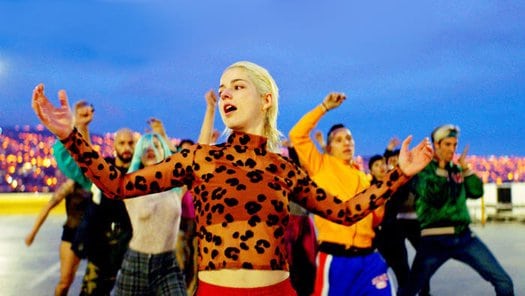Ema, a film by Pablo Larrain with reggaeton and flamethrowing
Posted: May 12th, 2020 | Author: Nicholas Minns | Filed under: Film | Tags: Catalina Saavedra, Christián Suárez, Gael Garcia Bernal, Gianinna Fruttero, Mariana Di Girolamo, Nicolas Jaar, Pablo Larrain, Paola Giannini, Reggaeton, Santiago Cabrera, Sergio Armstrong | Comments Off on Ema, a film by Pablo Larrain with reggaeton and flamethrowingEma, directed by Pablo Larrain

Film director Pablo Larrain was born in Chile and has evidently immersed himself in the history and politics of the country through cinema. He made a trilogy of films that cover the Pinochet years (Tony Manero, 2008; Post Mortem, 2010; and No, 2012), through which he must have gained an insight into the roots of contemporary Chilean society. In his most recent film, Ema, with a soundtrack by Nicolas Jaar, Larrain and his director of photography, Sergio Armstrong, paint a portrait of youthful life in the city of Valparaiso that is beautiful in an anarchic, hedonistic way but underneath the skin is an intimation of flesh made evil. The Spanish word for evil is ‘el mal’, which when spoken softly and elided sounds like Ema.
The film can be read at face value as the story of a young reggaeton dancer and teacher, Ema (Mariana Di Girolamo), who is married to an older, avant-garde choreographer/director, Gastón (Gael Garcia Bernal). When the film opens, we learn that since Gastón is infertile (‘a human condom’) the couple had adopted a Colombian child, Polo (Christián Suárez). Things did not work out — Polo set fire to the house, badly burning Ema’s sister — so they returned him to the care of the State. It appears from the social worker (Catalina Saavedra) that the adoption and un-adoption required a certain amount of illicit rule bending on her part for which she was paid under the table. The repercussions play out in a series of revelations that put a strain not only on the marriage but on the group of dancers on whom Gastón choreographs, some of whom are members of Ema’s reggaeton group. Out of this turmoil of mutual recrimination, guilt, corruption and violence, Ema forms her resolve to find Polo at whatever the cost.
This is where Larrain upgrades his story to a meta-narrative on the lines of Greek tragedy in which Ema’s inner determination merges with an inexorable external force. While her character is grounded in the reggaeton counterculture of Valparaiso, her slicked, platinum appearance is cast as both trendy feminine prototype and mythical vampire. She is handy with a flamethrower — a causal link to Polo’s actions — but her capricious predilection for destroying urban infrastructure goes entirely without civic challenge; for a thriving port city, Valparaiso under Armstrong’s eye becomes a denuded, dystopian backdrop to Ema’s exploits that lends the film an eerie sense of improbability. Such is the nature of dreams, but the dream overlaps strategically with the story. The only time the fire brigade arrives to extinguish a car she has torched is a narrative device to introduce her to one of the firemen, Anibal (Santiago Cabrera), who happens to be Polo’s new adoptive father. Even if Ema admits at the end of the film to having paid a social service psychologist to reveal the names and address of Polo’s new adoptive parents (and presumably their respective professions), she can hardly have anticipated Anibal’s arrival as part of the fire crew. Not content with seducing Anibal and becoming pregnant by him, Ema extends her rapacious scheme to get close to Polo’s new family by hiring Anibal’s wife Raquel (Paola Giannini), a divorce lawyer, to whom she offers seduction as payment for instigating divorce proceedings against Gastón. The folder is closed and the relationship begins.
Ema’s wanton seduction in pursuit of her goal involves a level of detachment that differentiates her from both her fellow dancers — Gianinna Fruttero as Sonia provides a fine earthy counterbalance — and her victims; the response of the seduced is more alluring than the posing of the seducer. Not even the charismatic presence of Bernal can compete with Di Girolamo’s forensic ambition; but if the meta-narrative of the film is that the politics of charm, seduction and serial determination can only succeed in a corrupt society, Ema’s role is as a psychologically one-dimensional femme fatale.
By choosing adoption as a theme, Larrain is perhaps alluding to the Pinochet years when babies from poor families were forcibly removed from their mothers to be sent abroad for adoption, and in using the dance form of reggaeton he places the context firmly with a rebellious younger generation that favours sensation over artifice, hedonism over order. Bringing together dance, flamethrowing and adoption as seductive metaphors for confronting the past offers emotional release but no stable solution. Larrain finishes his story with a superficially harmonious reunion of the two disaffected couples and their shared children, but immediately returns in the final scene to the violence of his meta-narrative, where dream and daily life converge once again. At a petrol station Ema is waiting while an attendant fills her portable tank.
Ema is available to stream on Mubi